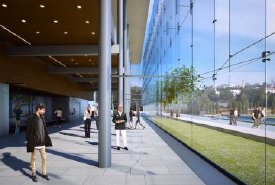Jan 27 2011
Helsinki is located at the same latitude as the southern tip of Greenland, on the coast of the Gulf of Finland. Here, temperatures below minus 15 degrees Celsius are nothing unusual, and the average annual temperature of 5 degrees does not pamper the city's 600,000 residents with a lot of heat.
This is the climate in which the new Helsinki Music Hall is currently being built – as a highly transparent glass cube. From the point of view of heat insulation this may seem daring, but LPR Architects and the façade construction specialist Normek Oy are making it possible – using triple-pane heat insulation glass from Interpane.

A total of 3,600 square metres of iplus neutral E effectively protects the hall from the cold. Since the thermometer can also rise to above 30 degrees in the short summer, protection from overheating plays a role as well. The planners met this challenge using ipasol neutral (70/39).
The old cultural heart of Helsinki, the Finlandia Hall from the 1970s, is no longer up-to-date – it has considerable acoustic flaws. Therefore, the city and the Helsinki Music Centre Foundation jointly opted for a modern new building and started the 140-million-euro project "Helsinki Music Hall". From the summer of 2011, it will accommodate 1,700 music lovers in its large concert hall and up to 400 in each of the five additional halls. Furthermore, the building will be home to the Helsinki Philharmonic Orchestra and the Finish Radio Symphony Orchestra as well as the Sibelius Academy, a music university with around 1,500 students and 400 teachers. There is also an extensive library as well as cafés and restaurants.
Glass architecture: open, transparent, attractive
The basic concept of the multi-functional hall is that its openness and transparency will make it a lively cultural meeting-point for everybody. This is one of the reasons why it was erected in the popular district of Töölönlahti, close to the city centre, directly on the way from the station to "Mannerheimintie", the 5.5 kilometre magnificent main street of Helsinki. The concert halls are completely surrounded by a spacious foyer in a brightly lit cube made of triple-pane insulation glass (iplus neutral E). The clear glass and the neutral functional coatings used ensure a true-colour view from the inside outwards and protect the building from losing heat at low ambient temperatures. Large parts of the western, southern and eastern side of the glass façade are additionally equipped with an ipasol neutral (70/39) solar control coating, which prevents the hall from turning into a sauna in the summer – even though these are particularly popular in Finland.
High requirements on construction planning
Planning the construction of the Helsinki Music Hall was a particularly challenging task. On the one hand, the large concert hall reaches a depth of 14 metres under the ground in order not to interrupt important existing lines of sight – the hall is located between the old Finlandia Hall and the Kiasma Museum of Contemporary Art, directly facing the Parliament of Finland. On the other hand, the ground water level near the shore of the Töölö Bay is very high, so that the underground part of the building had to be constructed as a completely waterproof "white tank". The busy nearby streets increased the requirements on soundproofing – vibrations and shaking of the building also had to be absorbed. Therefore, all the concert halls were "hung" into the building by means of supporting vibration dampers – right in the middle of the large all-glass façade, which is additionally stabilized by massive "glass fins" 60 centimetres wide and up to 6 metres high.
Point-fixed and structural glazing
Visitors enter the building with its total useable floor space of 36,000 square metres via the circumferential foyer. This provides a view in all directions, even into the sky through the glass roof. Plenty of light, protection from the cold and the sun, a minimum use of steel and a stable structure nevertheless – these were the requirements on construction. Therefore, the bulk of the façade glazing is point-fixed and stabilized by large glass fins made from laminated safety glass: two thermally-toughened glass panes, 15 mm thick, 60 cm wide and up to 6 metres long (heat soak tested according to EN 14179) made of low iron clear glass and laminated with a 1.52 mm thin PVB film. At the entrance and in the central area of the roof, the point fixing of the glazing gives way to structural glazing because of the appearance and for functional reasons.
The structure of the façade glazing varies depending on its spatial orientation. Fourteen variants are used in total. The ground floor, for example, has the following structure on the southern, eastern and western sides of the cube:
- Outer pane: 10 mm thermally-toughened, clear single-pane safety glass with ipasol neutral 70/39 solar control coating
- Space between the panes: 15 mm
- Intermediate pane: 8 mm thermally-toughened, clear single-pane safety glass
- Space between the panes: 15 mm
- Inner pane: 6.6.4 mm laminated clear safety glass with iplus neutral E thermal insulation coating
In the higher sections of the façade, the inner panes consist of thermally toughened single-pane safety glass. On the northern side, the ipasol solar control coating gives way to an additional heat insulation coating (iplus neutral E). Due to the use of clear glass and the efficient functional coatings, the interior of the hall benefits from a neutral view to the outside (Ra,D up to 97 percent) and high daylight transmittance (TL up to 74 percent), as well as excellent heat insulation and solar control. In the building envelope, the solar factor varies from 34 percent (central roof glazing) to 52 percent (northern face of the ground floor). The thermal insulation (Ug value) reaches 0.7 W/m2K in almost all parts of the façade, which provides the building with excellent protection against heat losses. In addition, the sophisticated triple glazing absorbs noise very efficiently – up to 43 dB (RW).